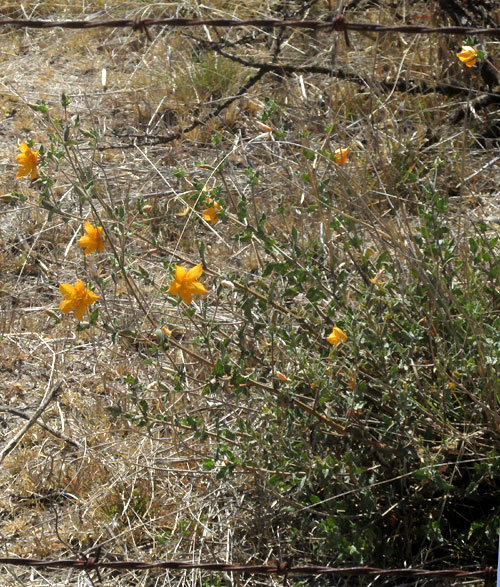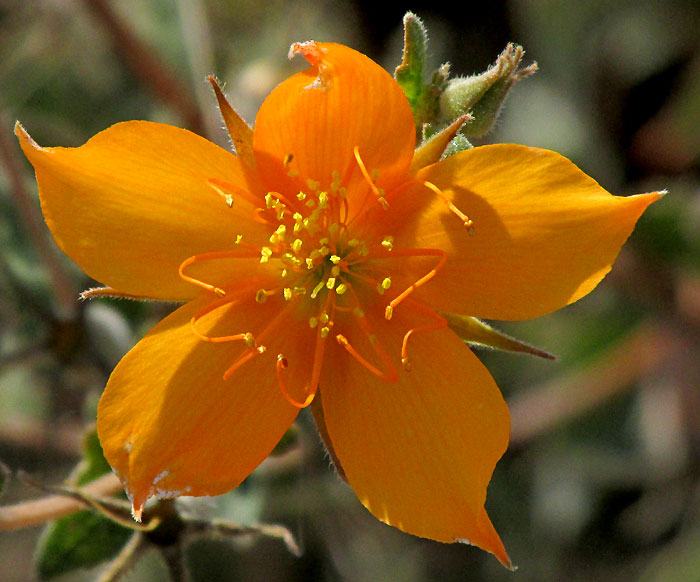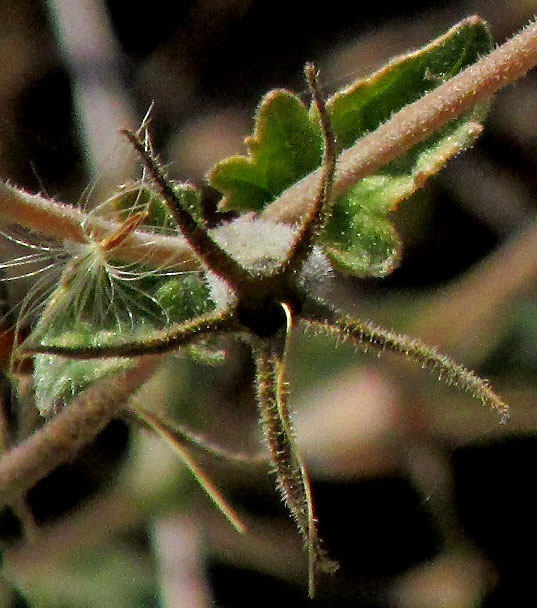Excerpts from Jim Conrad's
Naturalist Newsletter
entry dated May 30, 2022, issued from near Tequisquiapan, elevation about 1,900m (6200 ft), ~N20.57°, ~ W99.89°, Querétaro state, MÉXICO
BLAZINGSTAR FLOWERING

A couple of meters on the other side of a barbed-wire fence, the above wildflower offered some color to an otherwise late dry season landscape parched to tones of gray and brown, with the rains arriving late this year. Normally a barbed-wire fence is no barrier to taking closer looks, but this was near a village where people spotting a gringo slipping beneath a fence might not be a good idea, so all pictures were taken with a modest telephoto lens. Even so, the flowers proved to be surprisingly pretty, and interesting:

With the petals' tips curved to one side, lending the blossom a spiraling effect, and with so many stamens, with the outer stamens' filaments being much longer than the inner ones, and the outer ones curved into graceful arcs but the inner stamens with short, straight filaments, this was something unusual. A side view revealed more intriguing features:

With the orange petals and greenish sepals arising atop the ovary/future fruit, the flower has an "inferior ovary." That fact alone disqualifies most of the plant families you might guess this plant belongs to. The covering of short, stiff-looking hairs on everything except the corolla is noteworthy. The sepals are strangely large, stiff, sharp-pointed, and held away from the corolla. And in the above picture, note the out-of-focus, brown object at the lower left. That's a fruit atop which it's clear that the stiff, spine-like things atop the fruit are what becomes of the blossom's sepals. Here's a closer look at a fruit:

Already it can be guessed that the sharp, slender, hardened sepals have become barbs atop the fruit that later will snag onto fur of passing animals, providing the fruit with a dispersal mechanism. Also the entire fruit's coat of stiff hairs helps make the fruit stickier. The hair-like item snaking from the shadowed top of the fruit is the hardened remains of the flower's style. When the seeds are mature and the fruit is ready to disperse, valves atop the fruit open, allowing its 6-10 seeds to escape. In the above fruit picture also we see the general form of the small leaves: more or less triangular with shallow, rounded lobes, and very short petioles.
This is MENTZELIA HISPIDA, sometimes in English known as Blazingstar. The name Blazingstar might be applied to other similar species as well. Possibly it was coined for the species when it was thought to occur in the US. However, now the species is considered just to be found throughout most of Mexico, with a few populations occurring across the border in Guatemala. It occurs in arid scrub and pastures, oak-pine, oak and tropical deciduous forests.
In Spanish Mentzelia hispida often is called Pega Ropa, meaning more or less "Sticks to Clothing," which is a name applied to numerous species whose fruits stick to passing animals. A 2010 publication by Alberto Rojas-Martínez and others, entitled "Pega-ropa (Mentzelia hispida: Loasaceae), una planta que atrapa murciélagos" reports on bats being trapped and sometimes killed by the sticky plants, and suggests that bats who escape may help disperse the plant's seeds.
Mentzelia hispida is a member of the small, seldom-heard-of family sometimes known in English known as the Stickleaf Family, the Loasaceae. The memorable thing about the family is that the leaves are covered with various kinds of stiff hairs ranging in form from smooth and unbranched to knobby, notched, barbed, tree-like and stinging hairs. In the Yucatan often we saw a member of the family, Gronovia scandens, for which we got a good picture of its very stiff and sticky, doubly-hooked hairs.
Traditionally the plant has been documented as used medicinally as a purgative and to make one vomit.In 2021 John Schenk and others published a study entitled "The Species of Mentzelia (Loasaceae) in Mexico, part 1: Sectional diversity," in which it's stated that the concept of Mentzelia hispida is particularly confused because of its large distribution and many physical, or phenotypic, variations. In that paper several names seen in earlier publications are lumped into other species.